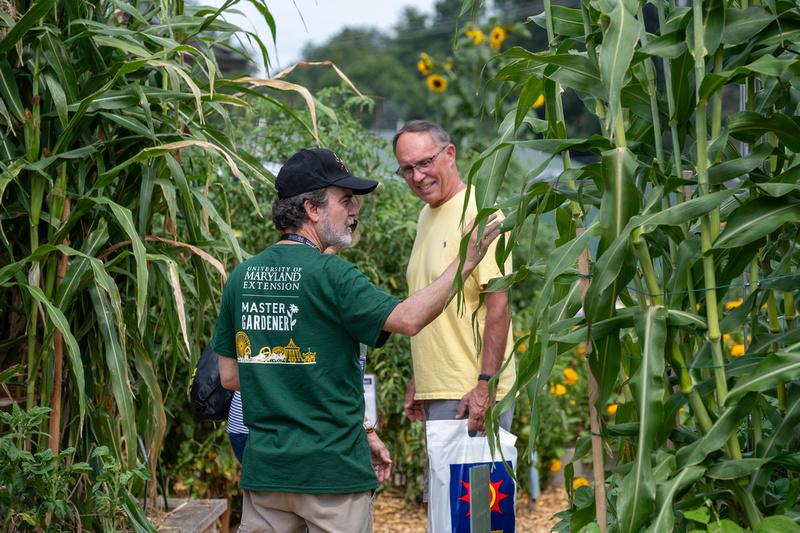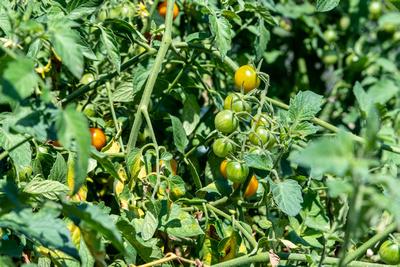Although the Maryland State Fair has officially ended, the University of Maryland Extension (UME) Baltimore County Master Gardeners will continue to visit the fairgrounds throughout the year to tend to the UME Learning Garden tucked in the north end alongside the 4-H/FFA Home Arts Building. But these visits will be in service of something greater than public demonstration.

For over a decade, this tiny green haven amidst the bustle of the state fair has demonstrated a variety of native plants and the pollinators that frequent them, attended by local certified Master Gardeners who act as interpreters during the fair, teaching Marylanders how they can grow their own gardens, no matter what space they have available. Now that the crowds have left, this small garden plays a new role, providing fresh produce for a local food pantry through a partnership with the Community Assistance Network.
“Whoever was volunteering would split up the produce. And we take care of the security guards who work at the fairgrounds all year, and share produce with them,” said Lori Rogers, a Master Gardener who has been involved with the UME Learning Garden project for over five years, and a certified UME volunteer since 2015. “But we’ve always struggled to find a place to donate the produce that we grow.”
During this first season, the Master Gardeners were able to donate over 29 pounds of Napa cabbage, 8 pounds of carrots, and 20 pounds of beets. “And this is just a brand new partnership – we didn’t plant or design the garden this year to produce food,” said Robert Cook, the UME Master Gardener who began the Learning Garden initiative in 2012 and remains a part of the steering committee, along with Rogers and fellow Master Gardener volunteer Anthony Nathe. “This winter, particularly if we can find out what the food bank would like us to grow in the spring when we’re not growing for the fair, we can use this space to produce a lot of food.”
While fair patrons only get to see what’s in bloom during late summer, work in the garden is a year-long endeavor and it consistently produces different varieties of vegetables, fruits, herbs, and flowers. “We take advantage of multiple growth cycles. We come out in the spring and plant lettuces and leafy greens, and harvest that. And then we decide what we want to plan for the fair in the fall,” said Rogers. “Over the next few months we’ll harvest the fall crop, and then put the garden to bed till spring.”
Starting as just a few mounded beds in 2012, Cook and his team have nurtured the space into raised beds, trellises, caged areas for wildlife protection, and a changing variety of local and native plants, creating an ever-evolving garden that demonstrates ways everyone can have green space.

“We want to show people that they can really grow anywhere, even on a slope. It just takes a little preparation and planning,” Cook said.
“It’s exciting – the new garden features, the new partnership – the Community Choice Pantry is a wonderful, huge food bank, and we can even take produce that hasn’t been washed,” said Rogers.
Not only does the Learning Garden show bed and variety options, the produce grown and donated to the pantry in Essex, Md. is also pesticide free. “At the Learning Garden, we don’t use any fertilizer or pesticides; we use really good soil that’s mostly mushroom compost,” Cook said. “But we tell everyone, any good organic compost is great for your beds. If the plants grow in really healthy soils, then they can fight off most bugs and diseases themselves.”
Fairgoers experience new additions to the demonstration garden every year, like the sorghum left by an anonymous local patron, the latest pest deterrent trial using vole netting beneath the sweet potato crop, the loofah highline which made a comeback after its popularity with visitors, or this year’s special exhibit, “Ten Tomatoes That Changed the World,” based on the book of the same title by William Alexander. Next year’s addition will include a list of produce donated through the Community Assistance Network.
“It’s a brand new relationship and we’re excited to be a part of it,” said Rogers. “We’re hoping that it will only continue to grow.”